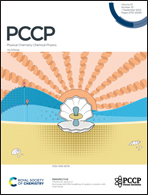New insights into pertinent Fe-complexes for the synthesis of iron via the instant polyol process†
Abstract
Chemically synthesized iron is in demand for biomedical applications due to its large saturation magnetization compared to iron oxides. The polyol process, suitable for obtaining Co and Ni particles and their alloys, is laborious in synthesizing Fe. The reaction yields iron oxides, and the reaction pathway remains unexplored. This study shows that a vicinal polyol, such as 1,2-propanediol, is suitable for obtaining Fe rather than 1,3-propanediol owing to the formation of a reducible Fe intermediate complex. X-ray absorption spectroscopy analysis reveals the ferric octahedral geometry and tetrahedral geometry in the ferrous state of the reaction intermediates in 1,2-propanediol and 1,3-propanediol, respectively. The final product obtained using a vicinal polyol is Fe with a γ-Fe2O3 shell, while the terminal polyol is favourable for Fe3O4. The distinct Fe–Fe and Fe–O bond lengths suggest the presence of a carboxylate group and a terminal alkoxide ligand in the intermediate of 1,2-propanediol. A large Fe–Fe bond distance suggests diiron complexes with bidentate carboxylate bridges. Prominent high-spin and low-spin states indicate the possibility of transition, which favors the reduction of iron ions in the reaction using 1,2-propanediol.



 Please wait while we load your content...
Please wait while we load your content...